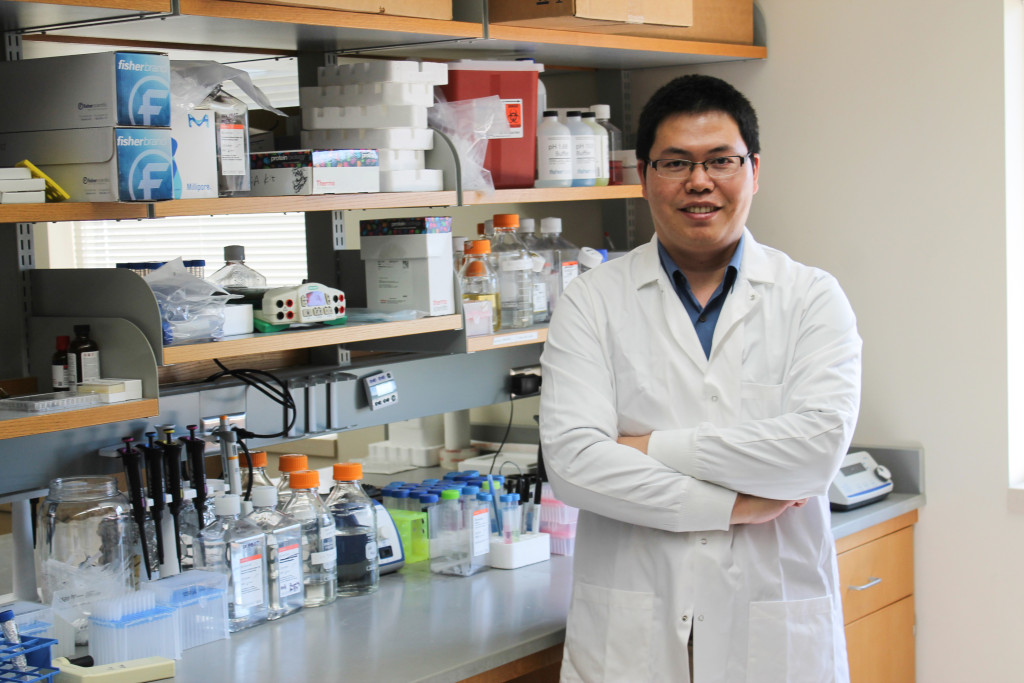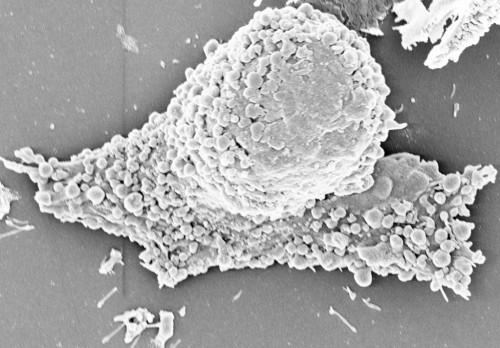
Quanyin Hu poses in his lab.
Using a newly discovered byproduct of dying cancer cells, University of Wisconsin-Madison researchers are developing personalized vaccines that could help keep aggressive tumors from recurring.
Led by Quanyin Hu, a professor in the UW-Madison School of Pharmacy, the research team has already found success slowing the recurrence of tumors in mouse models of triple negative breast cancer and melanoma. Currently, the long-term prognosis for human patients with these cancers is relatively poor. That's in part because the diseases have a tendency to recur after the initial treatments to remove the tumors.
The personalized vaccine approach is an extension of the team's recent discovery of pyroptotic vesicles, which are tiny sacs filled with the remnants of cancer cells when they undergo programmed cell death.
Crucially, the remnants in these microscopic sacs include antigens specific to the tumor, along with other molecular bits that can help direct immune cells to find and suppress cancer cells that might remain after a tumor is surgically removed.
In their study, recently published in the journal Nature Nanotechnology, Hu and his colleagues engineered these sacs to carry an immune stimulating drug. They then embedded these engineered vesicles into a hydrogel that can be implanted into the space left behind after surgical removal of a tumor.

This image shows the formation of pyroptotic vesicles, which look like small bubbles, in cancer cells as they undergo programmed cell death. A team of researchers led by UW-Madison pharmacy professor Quanyin Hu have developed a method for harnessing these vesicles to deliver vaccines against tumors with a high rate of recurrence. Image courtesy of Quanyin Hu
Using a melanoma mouse model and two different types of mouse models for triple negative breast cancers, including one with a human-derived tumor, the researchers compared their new approach with other cancer vaccine methods being studied. The mice that received the hydrogel laden with their engineered sacs survived significantly longer than others.
"Compared to the other approaches, ours shows a much stronger immune response," says Hu. "We were one of the first groups to identify these pyrotopic vesicles and the first to show their effectiveness in helping prevent cancer recurrence, and we are very excited about their potential."
Hu says the approach could theoretically apply to any cancer that tends to recur, such as pancreatic cancer and glioblastoma, the most common and extremely aggressive brain tumor. This potential is because the engineered sacs contain molecular information that is unique to an individual's cancer cells, meaning the immune response they create is uniquely positioned to attack those cells.
Another advantage of this approach is the localized nature of the treatment. Most cancer vaccines under development carry the risk for severe side effects because of how they're given - through systemic injections. Hu says that applying the engineered vesicles directly to the site of the removed tumor greatly reduces the risk of systemic side effects.
While the approach will require more testing in mice and other animal models before it can be tested in humans, Hu is bullish about its potential. Several of the mice that received the highest doses of the experimental treatment remained cancer free throughout the course of the study.
"That's really exciting because we demonstrated that we could essentially cure these mice with no tumor recurrence," Hu says.
This research was supported in part by the National Institutes of Health (R01EB035992 and R01CA288851), the American Cancer Society (RSG-23-1140821-01-ET) and the METAVIVOR Foundation.






